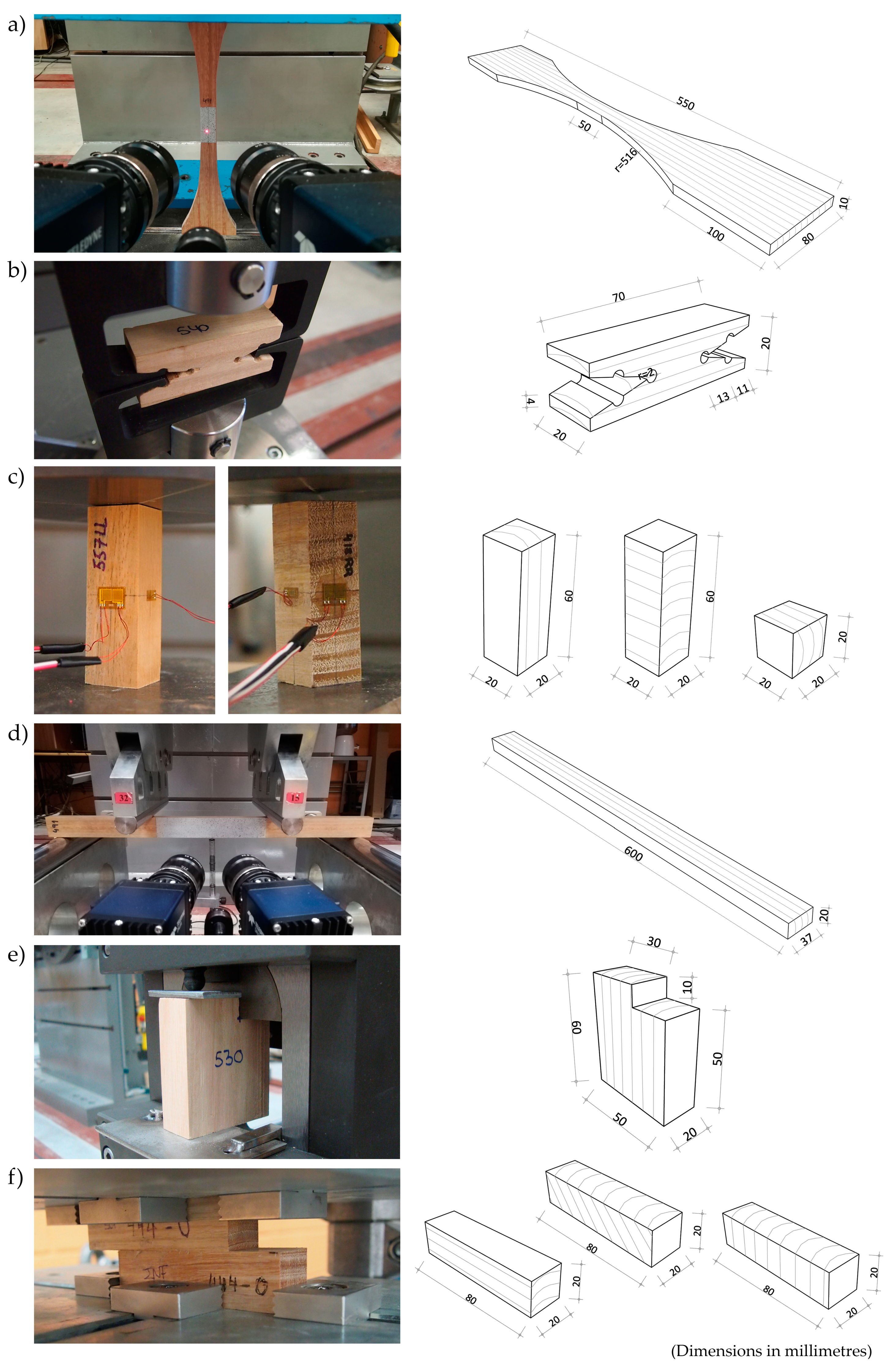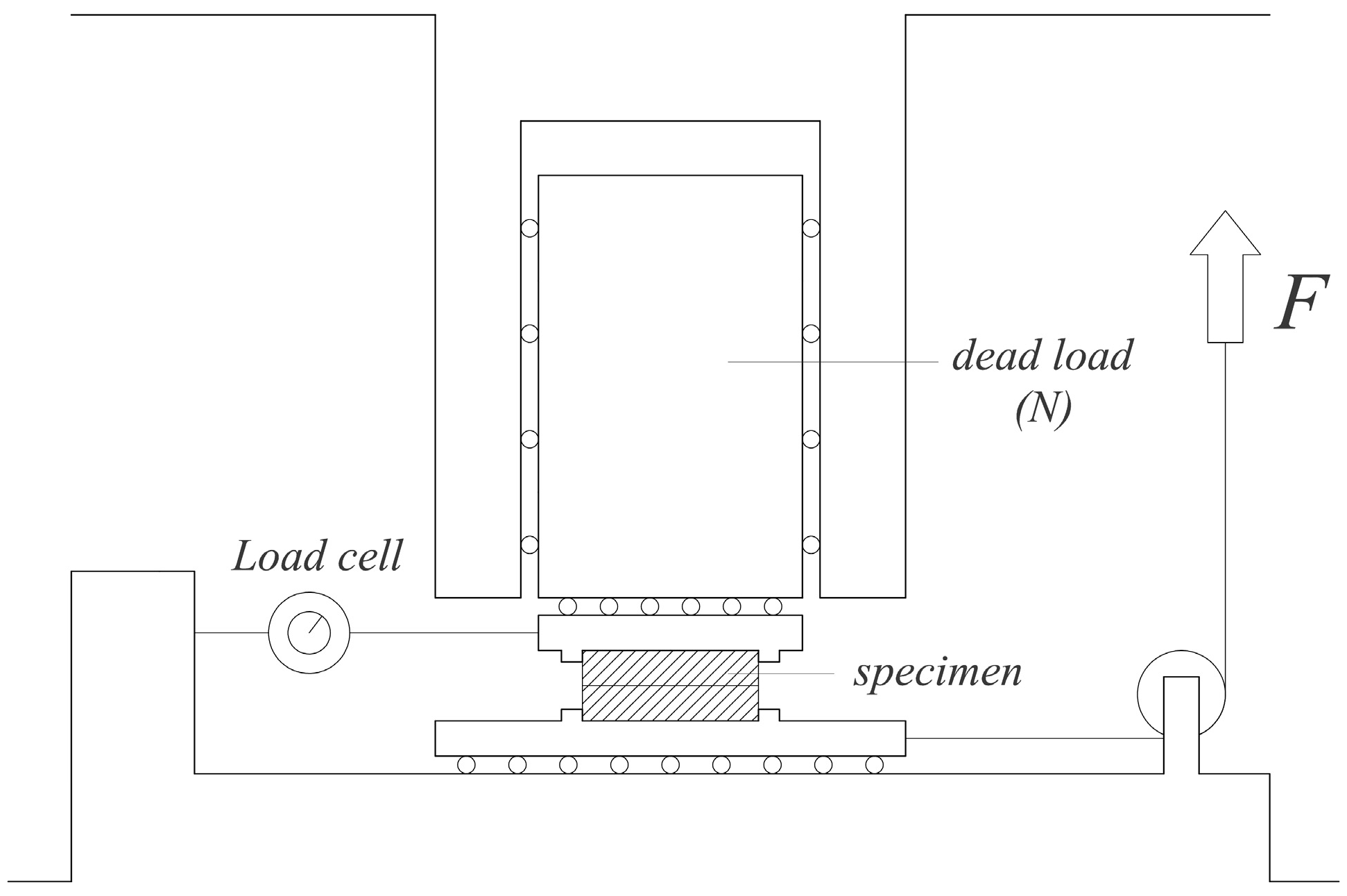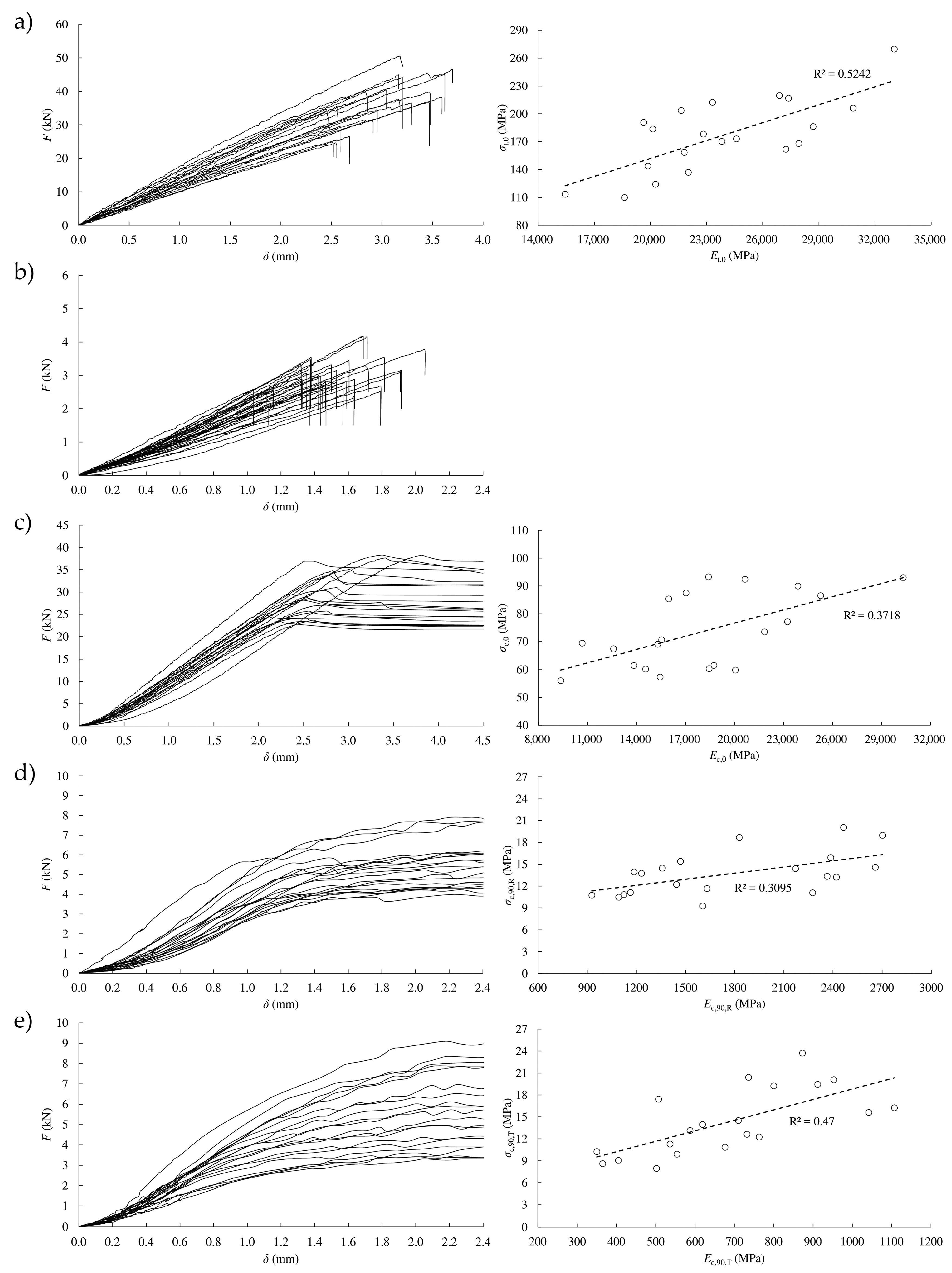Mechanical Properties of Small Clear Specimens of Eucalyptus globulus Labill
Abstract
:1. Introduction
2. Materials and Methods
2.1. Specimens
2.2. Experimental Methods
3. Results and Discussion
4. Conclusions
Author Contributions
Funding
Conflicts of Interest
References
- Aicher, S.; Christian, Z.; Dill-Langer, G. Hardwood glulams—Emerging timber products of superior mechanical properties. In Proceedings of the World Conference on Timber Engineering, Quebec City, QC, Canada, 10–14 August 2014. [Google Scholar]
- Potts, B.M.; Vaillancourt, R.E.; Jordan, G.; Dutkowski, G.; da Costa e Silva, J.; McKinnon, G.; Steane, D.; Volker, P.; Lopez, G.; Apiolaza, L.; et al. Exploration of the Eucalyptus globulus gene pool. In Proceedings of the Eucalyptus in a Changing World—International IUFRO Conference, Aveiro, Portugal, 11–15 October 2004. [Google Scholar]
- UNE 56546:2013. Visual Grading for Structural Sawn Timber: Hardwood Timber; The Spanish Association for Standardization and Certification (AENOR): Madrid, Spain, 2013. (In Spanish) [Google Scholar]
- EN 1912:2012. Structural Timber Strength Classes—Assignment of Visual Grades and Species; The Spanish Association for Standardization and Certification (AENOR): Madrid, Spain, 2012. [Google Scholar]
- EN 350:2016. Durability of Wood and Wood-Based Products—Testing and Classification of the Durability to Biological Agents of Wood and Wood-Based Materials; The Spanish Association for Standardization and Certification (AENOR): Madrid, Spain, 2016. [Google Scholar]
- Franke, S.; Marto, J. Investigation of Eucalyptus globulus wood for the use as an engineered material. In Proceedings of the World Conference on Timber Engineering, Quebec City, QC, Canada, 10–14 August 2014. [Google Scholar]
- López-Suevos, F.; Richter, K. Hydroxymethylated resorcinol (HMR) and novolak-based HMR (n-HMR) primers to enhance bond durability of Eucalyptus globulus glulams. J. Adhes. Sci. Technol. 2009, 23, 1925–1937. [Google Scholar] [CrossRef]
- Lara-Bocanegra, A.J.; Majano-Majano, A.; Crespo, J.; Guaita, M. Finger-jointed Eucalyptus globulus with 1C-PUR adhesive for high performance engineered laminated products. Constr. Build. Mater. 2017, 135, 529–537. [Google Scholar] [CrossRef]
- Pangh, H.; Hosseinabadi, H.Z.; Kotlarewski, N.; Moradpour, P.; Lee, M.; Nolan, G. Flexural performance of cross-laminated timber constructed from fibre-managed plantation eucalyptus. Constr. Build. Mater. 2019, 208, 535–542. [Google Scholar] [CrossRef]
- Derikvand, M.; Jiao, H.; Kotlarewski, N.; Michael, L.; Chan, A.; Nolan, G. Bending performance of nail-laminated timber constructed of fast-grown plantation eucalypt. Eur. J. Wood Wood Prod. 2019, 77, 421–437. [Google Scholar] [CrossRef]
- Schmidt, J.; Kaliske, M. Models for numerical failure analysis of wooden structures. Eng. Struct. 2009, 31, 571–579. [Google Scholar] [CrossRef]
- Gibson, L.J.; Ashby, M.F. Cellular Solids-Structure and Properties; Cambridge University Press: Cambridge, UK, 2001. [Google Scholar]
- Caldeira, T.V.P.; Dourado, N.; de Jesus, A.M.P.; de Moura, M.F.S.F.; Morais, J.J.L. Quasi-static behavior of moment-carrying steel-wood doweled joints. Constr. Build. Mater. 2014, 53, 439–447. [Google Scholar] [CrossRef]
- Franke, B.; Quenneville, P. Numerical modelling of the failure behaviour of dowel connections in wood. J. Eng. Mech. 2011, 137, 186–195. [Google Scholar] [CrossRef]
- Villar, J.R.; Guaita, M.; Vidal, P.; Arriaga, F. Analysis of the stress state at the cogging joint in timber structures. Biosyst. Eng. 2007, 96, 79–90. [Google Scholar] [CrossRef]
- Crespo, J.; Aira, J.R.; Vázquez, C.; Guaita, M. Comparative analysis of the elastic constants measured via conventional, ultrasound, and 3-D Digital Image Correlation methods in Eucalyptus globulus. Bioresources 2017, 12, 3728–3743. [Google Scholar] [CrossRef] [Green Version]
- Crespo, J.; Majano-Majano, A.; Xavier, J.; Guaita, M. Determination of the resistance-curve in Eucalyptus globulus through double cantilever beam tests. Mater. Struct. 2018, 51, 77. [Google Scholar] [CrossRef]
- Majano-Majano, A.; Lara-Bocanegra, A.J.; Xavier, J.; Morais, J. Measuring the cohesive law in mode I loading of Eucalyptus globulus. Materials 2019, 12, 23. [Google Scholar] [CrossRef] [PubMed] [Green Version]
- Majano-Majano, A.; Lara-Bocanegra, A.J.; Xavier, J.; Morais, J. Experimental Evaluation of Mode II fracture Properties of Eucalyptus globulus L. Materials 2020, 13, 745. [Google Scholar] [CrossRef] [PubMed] [Green Version]
- ISO 13061-1:2014. Physical and Mechanical Properties of Wood—Test Methods for Small Clear Wood Specimens—Part 1: Determination of Moisture Content for Physical and Mechanical Tests; International Organization for Standardization: Geneva, Switzerland, 2014. [Google Scholar]
- ISO 13061-2:2014. Physical and Mechanical Properties of Wood—Test Methods for Small Clear Wood Specimens—Part 2: Determination of Density for Physical and Mechanical Tests; International Organization for Standardization: Geneva, Switzerland, 2014. [Google Scholar]
- ISO 13061-6:2014. Physical and Mechanical Properties of Wood—Test Methods for Small Clear Wood Specimens—Part 6: Determination of Ultimate Tensile Stress Parallel to Grain; International Organization for Standardization: Geneva, Switzerland, 2014. [Google Scholar]
- GOM mbH. ARAMIS Commercial Software; ARAMIS 6.0.2; GOM mbH: Braunschweig, Germany, 2007. [Google Scholar]
- UNE 56538:1978. Physical-Mechanical Characteristics of Wood: Determination of Strength in Tension Perpendicular to the Grain; The Spanish Association for Standardization and Certification (AENOR): Madrid, Spain, 1978. [Google Scholar]
- ISO 13061-17:2017. Physical and Mechanical Properties of Wood—Test Methods for Small Clear Wood Specimens—Part 17: Determination of Ultimate Stress in Compression Parallel to Grain; International Organization for Standardization: Geneva, Switzerland, 2017. [Google Scholar]
- ISO 13061-5:2020. Physical and Mechanical Properties of Wood—Test Methods for Small Clear Wood Specimens—Part 5: Determination of Strength in Compression Perpendicular to Grain; International Organization for Standardization: Geneva, Switzerland, 2020. [Google Scholar]
- EN 408:2011. Timber Structures—Structural Timber and Glued Laminated Timber—Determination of Some Physical and Mechanical Properties; The Spanish Association for Standardization and Certification (AENOR): Madrid, Spain, 2011. [Google Scholar]
- UNE 56543:1988. Physical-Mechanical Characteristics of Wood: Determination of Shear Stress; The Spanish Association for Standardization and Certification (AENOR): Madrid, Spain, 1988. [Google Scholar]
- Crespo Outes, J.; Regueira Gay, R.; Soilán Cañás, A.; Diez Barra, M.R.; Guaita Fernández, M. Desarrollo de metodología para la determinación de los coeficientes de fricción estático y dinámico de diferentes especies de madera (In English: Development of methodology for the determination of static and dynamic friction coefficients of different wood species). In Proceedings of the CIMAD 11—1° Congresso Ibero-Latino Americano da Madeira na Construção, Coimbra, Portugal, 7–9 June 2011. [Google Scholar]
- Baño, V.; Argüelles-Bustillo, R.; Regueira, R.; Guaita, M. Determination of the stress-strain curve in specimens of Scots pine for numerical simulation of defect free beams. Mater. Constr. 2012, 62, 269–284. [Google Scholar] [CrossRef] [Green Version]
- Fernández-Golfín, J.I.; Díez, M.R.; Baonza, M.V.; Gutiérrez, A.; Hermoso, E.; Conde, M.; Van den Eynde, V. Quality and properties of Spanish Laricio Pine (Pinus nigra Arn. Salzmannii). For. Syst. 2001, 10, 311–331. (In Spanish) [Google Scholar]
- Green, D.W. Wood: Strength and Stiffness. In Encyclopedia of Materials: Science and Technology; Elsevier Science Ltd.: Amsterdam, The Netherlands, 2001; pp. 9732–9736. [Google Scholar]
- Gherardi Hein, P.R.; Brancheriau, L. Comparison between three-point and four-point flexural tests to determine wood strength of eucalyptus specimen. Maderas Cienc. Tecnol. 2018, 20, 333–342. [Google Scholar] [CrossRef] [Green Version]
- Kretschmann, D.E. Mechanical Properties of Wood. In Wood Handbook—Wood as an Engineering Material; Forest Products Laboratory: Madison, WI, USA, 2010. [Google Scholar]








| Mechanical Property | Symbol | n | Mean | SD | CoV |
|---|---|---|---|---|---|
| Tension parallel to grain | |||||
| Ultimate stress (MPa) | σt,0 | 20 | 176.3 | 39.6 | 22% |
| Modulus of elasticity (GPa) | Et,0 | 20 | 23.80 | 4466 | 19% |
| Tension perpendicular to grain | |||||
| Ultimate stress (MPa) | σt,90 | 36 | 7.5 | 1.2 | 16% |
| Compression parallel to grain | |||||
| Ultimate stress (MPa) | σc,0 | 20 | 73.6 | 13.4 | 18% |
| Modulus of elasticity (GPa) | Ec,0 | 20 | 18.06 | 5155 | 29% |
| Compression perpendicular to grain | |||||
| Proportional limit stress—radial (MPa) | σc,90,R,y | 20 | 11.1 | 2.5 | 22% |
| Modulus of elasticity—radial (GPa) | Ec,90,R | 20 | 1.78 | 595 | 33% |
| Stress at 2mm deformation—radial (MPa) | σc,90,R,2 | 20 | 13.0 | 2.8 | 22% |
| Proportional limit stress—tangential (MPa) | σc,90,T,y | 20 | 10.2 | 4.0 | 39% |
| Modulus of elasticity—tangential (GPa) | Ec,90,T | 20 | 0.69 | 218 | 32% |
| Stress at 2mm deformation—tangential (MPa) | σc,90,T,2 | 20 | 13.6 | 4.4 | 33% |
| Static bending | |||||
| Ultimate stress (MPa) | σm | 22 | 124.1 | 22.2 | 18% |
| Modulus of elasticity (GPa) | Em | 22 | 22.27 | 4170 | 19% |
| Shear parallel to grain | |||||
| Ultimate stress (MPa) | σv | 44 | 16.2 | 3.0 | 19% |
| Friction coefficient | |||||
| 0° | μs,0 | 44 | 0.08 | 0.04 | 50% |
| 45° | μs,45 | 43 | 0.20 | 0.08 | 40% |
| 90° | μs,90 | 43 | 0.24 | 0.09 | 36% |
© 2020 by the authors. Licensee MDPI, Basel, Switzerland. This article is an open access article distributed under the terms and conditions of the Creative Commons Attribution (CC BY) license (http://creativecommons.org/licenses/by/4.0/).
Share and Cite
Crespo, J.; Majano-Majano, A.; Lara-Bocanegra, A.J.; Guaita, M. Mechanical Properties of Small Clear Specimens of Eucalyptus globulus Labill. Materials 2020, 13, 906. https://doi.org/10.3390/ma13040906
Crespo J, Majano-Majano A, Lara-Bocanegra AJ, Guaita M. Mechanical Properties of Small Clear Specimens of Eucalyptus globulus Labill. Materials. 2020; 13(4):906. https://doi.org/10.3390/ma13040906
Chicago/Turabian StyleCrespo, Jorge, Almudena Majano-Majano, Antonio José Lara-Bocanegra, and Manuel Guaita. 2020. "Mechanical Properties of Small Clear Specimens of Eucalyptus globulus Labill" Materials 13, no. 4: 906. https://doi.org/10.3390/ma13040906





